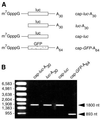Peptide-mediated RNA delivery: a novel approach for enhanced transfection of primary and post-mitotic cells
- PMID: 11557821
- PMCID: PMC55922
- DOI: 10.1093/nar/29.18.3882
Peptide-mediated RNA delivery: a novel approach for enhanced transfection of primary and post-mitotic cells
Abstract
Synthetic vectors were evaluated for their ability to mediate efficient mRNA transfection. Initial results indicated that lipoplexes, but not polyplexes based on polyethylenimine (PEI, 25 and 22 kDa), poly(L-lysine) (PLL, 54 kDa) or dendrimers, mediated efficient translation of mRNA in B16-F10 cells. Significant mRNA transfection was achieved by lipoplex delivery in quiescent (passage 0) human umbilical vein endothelial cells (HUVEC), and by passage 4, 10.7% of HUVEC were transfected compared to 0.84% with DNA. Lack of expression with PEI 25 kDa/mRNA or PLL 54 kDa/mRNA in a cell-free translation assay and following cytoplasmic injection into Rat1 cells indicated that these polyplexes were too stable to release mRNA. In contrast, polyplexes formed using smaller PEI 2 kDa and PLL 3.4 kDa gave 5-fold greater expression in B16-F10 cells compared to DOTAP, but were dependent on chloroquine for transfection activity. Endosomolytic activity was incorporated by conjugating PEI 2 kDa to melittin and resulting PEI 2 kDa-melittin/mRNA polyplexes mediated high transfection levels in HeLa cells (31.1 +/- 4.1%) and HUVEC (58.5 +/- 2.9%) in the absence of chloroquine, that was potentiated to 52.2 +/- 2.7 and 71.6 +/- 1.7%, respectively, in the presence of chloroquine. These results demonstrate that mRNA polyplexes based on peptide-modified low molecular weight polycations can possess versatile properties including endosomolysis that should enable efficient non-viral mRNA transfection of quiescent and post-mitotic cells.
Figures








References
-
- Pollard H., Remy,J.S., Loussouarn,G., Demolombe,S., Behr,J.P. and Escande,D. (1998) Polyethylenimine but not cationic lipids promotes transgene delivery to the nucleus in mammalian cells. J. Biol. Chem., 273, 7507–7511. - PubMed
-
- Brunner S., Sauer,T., Carotta,S., Cotten,M., Saltik,M. and Wagner,E. (2000) Cell cycle dependence of gene transfer by lipoplex, polyplex and recombinant adenovirus. Gene Ther., 7, 401–407. - PubMed
-
- Nair S.K., Boczkowski,D., Morse,M., Cumming,R.I., Lyerly,H.K. and Gilboa,E. (1998) Induction of primary carcinoembryonic antigen (CEA)-specific cytotoxic T lymphocytes in vitro using human dendritic cells transfected with RNA. Nat. Biotechnol., 16, 364–369. - PubMed
-
- Strobel I., Berchtold,S., Gotze,A., Schulze,U., Schuler,G. and Steinkasserer,A. (2000) Human dendritic cells transfected with either RNA or DNA encoding influenza matrix protein M1 differ in their ability to stimulate cytotoxic T lymphocytes. Gene Ther., 7, 2028–2035. - PubMed
Publication types
MeSH terms
Substances
LinkOut - more resources
Full Text Sources
Other Literature Sources
Miscellaneous

